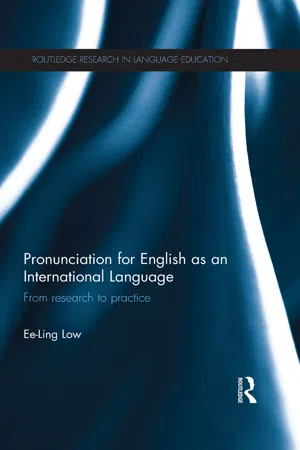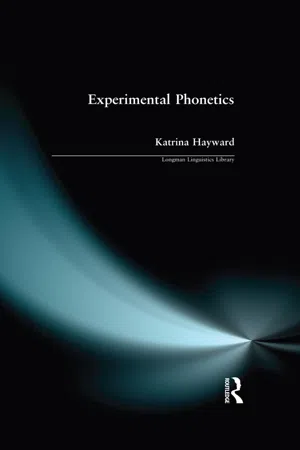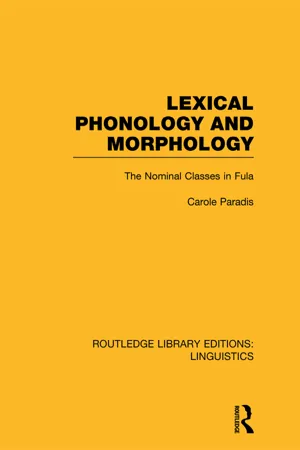Languages & Linguistics
Consonants
Consonants are speech sounds produced by obstructing the airflow in the vocal tract. They are characterized by the constriction or closure of the articulators, such as the lips, tongue, or teeth. In the International Phonetic Alphabet (IPA), consonants are classified based on their manner of articulation, place of articulation, and voicing.
Written by Perlego with AI-assistance
8 Key excerpts on "Consonants"
Learn about this page
Index pages curate the most relevant extracts from our library of academic textbooks. They’ve been created using an in-house natural language model (NLM), each adding context and meaning to key research topics.
- eBook - ePub
Phonetics
Transcription, Production, Acoustics, and Perception
- Henning Reetz, Allard Jongman(Authors)
- 2011(Publication Date)
- Wiley-Blackwell(Publisher)
milk can be represented as CVCC.) Sounds are classified as Consonants or vowels mainly on the basis of how they are articulated or produced. For the articulation of vowels, the oral cavity is relatively open – in other words, the airflow is quite unobstructed. In addition, the vocal folds are usually vibrating. For Consonants, on the other hand, the airstream is affected in a number of ways; it can either be:1 blocked, resulting in an (oral) stop consonant; 2 impeded, resulting in either a fricative with a major constriction or an approximant with a minor constriction; 3 diverted through the nasal cavity, resulting in a nasal consonant.In addition, the vocal folds may or may not be vibrating, resulting in voiced or voiceless (= unvoiced) sounds.From now on, speech sounds will be classified as either Consonants or vowels. We will start with the Consonants. In order to produce a consonant, the airstream through the vocal tract must be obstructed in some way. Consonants can therefore be classified according to the location and extent of this obstruction, or, in linguistic terms, the place and manner of articulation. We start by describing the Consonants of English in terms of their place and manner of articulation. In Chapter 4 we expand this description to sounds found in other languages of the world.2.3.1 Place of articulation
Going from front to back in the vocal tract, the following places of articulation can be distinguished in English:1 Bilabial. Bilabials are produced with both lips. Examples in English are the initial sounds in the wordsp eak,b eak, andm eek.2 Labiodental. The lower lip makes contact with the upper front teeth. Examples are the initial sounds in the wordsf ineandv ine.3 Dental. Dental Consonants involve the tip or blade of the tongue and the upper front teeth. Examples are the initial sounds inth ighandth y.4 Alveolar. These sounds involve the tip or blade of the tongue and alveolar ridge as int ip,d ip,s ip,z ip,l ip,r ip, andn ip. (For a discussion of the retroflex variant of “r,” see Section 3.1.5.)5 Postalveolar. These sounds involve the tongue tip or blade and the back of the alveolar ridge. The tongue is raised towards the alveolar ridge and the front of the hard palate. Examples are the initial sounds in s - eBook - ePub
Pronunciation for English as an International Language
From research to practice
- Ee-Ling Low(Author)
- 2014(Publication Date)
- Routledge(Publisher)
5 Consonants DOI: 10.4324/9781315814131-5Chapter 2 has given a detailed coverage of what is involved in a full description of the articulation of Consonants, namely voicing, place and manner of articulation. Crystal (2008 , p. 103) considers describing the voicing, place and manner to be part of the phonetic description of Consonants but it is also important to point out that Consonants, unlike vowels, do have a constriction in the airflow caused by the contact with the articulators and, for this reason, we are able to be very specific about their place and manner of articulation. This also makes it easy, if required, to point others to specific places and manner of articulation for producing specific Consonants when learning a new language. This chapter will first talk about some phonological aspects of describing Consonants in English, then go on to point out what recent research has shown about Consonants in different varieties of English in the Outer and Expanding Circles, first starting with the overview offered by Mesthrie (2004) and then moving on to more recent acoustic studies on Consonants in varieties spoken in these two circles. Finally, a discussion of the implications of the research findings for pronunciation practice for EIL will be elucidated.Phonological description of Consonants
As mentioned in Chapter 4 , unlike vowels, Consonants do not form the syllable nuclei. Instead, in English, initial and final consonant clusters do not constitute the obligatory component of the syllable and are optional. Having said that, I had also earlier pointed out in Chapter 4 that, in some cases, Consonants can form the syllable nuclei and when they function in this capacity, they are called syllabic and three main Consonants can fulfil this role, namely syllabic [l, m, n] notated as - David Hornsby(Author)
- 2014(Publication Date)
- Teach Yourself(Publisher)
voiceless. All vowels in English are voiced; Consonants may be voiceless or voiced.Speech sounds may also be oral or nasal, depending on whether or not the velum (or soft palate) is lowered to allow air to pass through the nose as well as the mouth. English has only oral vowels, but nasal and oral Consonants; French, Portuguese and Polish have nasal vowels as well as nasal Consonants. Consonants are produced by full or partial obstruction of the airstream, while vowels are produced by positioning the tongue in different configurations which do not impede the flow of air. The distinction, however, is not a clear-cut one and some sounds classified as Consonants have vowel-like qualities.You might find it helpful to think in terms of a continuum or sonority hierarchy with highly vocalic or ‘vowel-like’ sounds like [a ] (as in British English ra t) at the top and strongly consonantal sounds like [p ] in p ip at the bottom. Stressed syllables in English must have a vowel as their head or nucleus (see Chapter 5 ), while Slovak, for example, allows sounds further down the sonority hierarchy, such as [r ] in the place name Br no, to occupy this position.(Clark and Yallop 1995: 36)In general, consonantal sounds show greater constriction of the vocal tract than vocalic sounds and have less prominence.Spotlight: The International Phonetic Alphabet (IPA)First published in 1888, and revised several times since (most recently in 2005) in the light of new discoveries, the International Phonetic Alphabet provides a notational standard for the phonetic representation of all languages. The IPA uses symbols representing speech sounds, which are conventionally placed in square brackets. Unlike conventional written characters or graphemes, IPA symbols have a constant value, so while the letter g is pronounced differently in gap, gnaw and beige, the symbol [g ] always represents a voiced velar plosive, i.e. the sound in gap- eBook - ePub
Experimental Phonetics
An Introduction
- Katrina Hayward(Author)
- 2014(Publication Date)
- Routledge(Publisher)
- Spectral structure. For example, the nasal [n] and the lateral [l], which have some general characteristics in common, show differences in their spectra during the constriction interval. Outside the interval, for all Consonants the starting points and trajectories of the formant transitions (both preceding and following) play a major role as cues for place of articulation.
All three of the main acoustic dimensions just mentioned (presence vs. absence of aperiodic energy, timing, spectral structure) are necessary to define the impressionistic-phonetic categories of place of articulation, manner of articulation and voicing in acoustic terms.7.2.3 Acoustic boundaries and ConsonantsAnother way of approaching the description of Consonants, at least when they occur before vowels, is to compare the spectrum of the interval sound with the spectrum of the onset of the following vowel. For example, to compare /ʃ/ with /ɑ/ in Figure 7.1 , we should note that the lower edge of the band of noise in /ʃ/ (just below 2000 Hz) is at roughly the same height at the onset of F3 for /ɑ/ The darkest part of the band (just below 3000 Hz) is between F3 and F4 .The general hypothesis behind this approach is that the acoustic boundary between consonant and vowel is of particular importance for the listener. It is at acoustic boundaries that abrupt changes occur in the spectrum to which the auditory system may be particularly sensitive (Section 5.3.4 ). To quote Stevens (1985b: 253), ‘Either the acoustic correlates of phonetic features consist of specification of how the spectrum is changing in this region, or the region provides a landmark that indicates where nearby spectral or temporal information is to be sampled.’I shall now give an overview of the acoustic characteristics of various types of Consonants, organised according to manner of articulation.7.3 Stop Consonants27.3.1 General characteristics of stop ConsonantsDuring the production of stop Consonants, there is a complete closure somewhere in the vocal tract, cutting off the airstream from the lungs. The soft palate is raised, so that air cannot escape through the nasal cavity. If the vocal folds are not vibrating, no sound will be produced at all, resulting in a period of silence. On the other hand, during the closure period, air pressure is building up behind the closure. If a vowel immediately follows, release of the closure will be accompanied by a brief burst of noise, appropriately known as the burst - Walter Dunson(Author)
- 2021(Publication Date)
- Routledge(Publisher)
/ r /- glides: sounds produced by moving the tongue rapidly in a gliding fashion either toward or away from a neighboring vowel. They are always preceded or followed by a vowel and include:
- O lingua-palatal glide: / y /
- O bilabial glide: / w /
- nasals: sounds produced as air is emitted through the nasal cavity, such as:
- O bilabial nasal: / m /
- O lingua-alveolar nasal: /n/
- O lingua-velar nasal: / ng /
Understanding ConsonantsThe 21 Consonants in the English language take on various sounds and pronunciations. Table 3 provides a breakdown of each consonant, its pronunciation, and a key word for each consonant. The table also shares some notes for when the pronunciations of Consonants differ.Hie specific articulation of Consonants takes place using different parts of the articulatory tract. Knowledge of the oral mechanics required to generate consonant sounds provides students with an additional tactile tool as manipulation of the tract of articulation allows students struggling with auditory discrimination issues to better isolate individual sounds. For example, if students feel the back of the tongue rise to the velum (hard palate) and move forward, scraping gently, there are only two sounds that may be generated using this sequence of oral movements: the “k” or the “g.”The Consonants are articulated in the following manner:- / p /,./ b /, and / m /: Hie bilabials (/ p /, / b /, and /m/) are articulated by pressing both lips together. For the unvoiced / p /, the lips are closed. Slight air pressure is built up. A light puff of air is exploded through the oral cavity by the sudden parting of the lips. Voice is added for / b /. For / m /, the voiced breath stream is emitted through the nasal cavity.
- /f/ and / v/: The labio-dentals (/f / and / v /) are articulated by touching the bottom lip to the upper teeth. For / f/, the lower lip approximates the upper incisors. Friction is created as air is emitted through the oral cavity between the teeth and lip. For / v
- eBook - ePub
- Mike Davenport, S.J. Hannahs(Authors)
- 2020(Publication Date)
- Routledge(Publisher)
ConsonantsAs we saw in Chapter 2 , the class of Consonants can be divided into a number of subgroupings on the basis of their manner of articulation. The first division we will consider here is obstruent versus sonorant. For obstruents, the airflow is noticeably restricted, with the articulators either in complete closure or close approximation. For sonorants, either there is no such restriction in the oral tract or the nasal tract is open; either way, the air has free passage through the vocal tract. The class of obstruents can be further subdivided into stops, fricatives and affricates, again on the basis of stricture type. The class of sonorant Consonants can be subdivided into nasals, liquids and glides (vowels are also sonorants, but not sonorant Consonants).A further important distinction between obstruents and sonorants is that while the various obstruent subtypes listed may have both voiced and voiceless counterparts in most languages, sonorant subtypes are typically only voiced. Thus English can distinguish ‘pad’ from ‘bad’ due to the voicing contrast of the initial bilabial obstruents (stops) represented orthographically by ‘p’ and ‘b’. With sonorants no such pairs exist; for the nasals, for example, there is only one bilabial – the (voiced) nasal found in ‘mad’ – and no voiceless bilabial nasal.This chapter looks in some detail at consonantal articulation types, starting with those having the narrowest stricture, the stops and affricates, moving through more open strictures to the fricatives and then to nasals and liquids, ending with the class with the widest stricture setting, the glides. For each class of consonant, there is a description of its production at different places of articulation and a discussion of any significant variation exhibited (both positional variation, in terms of what happens when the sound occurs in different positions within a sequence of sounds, and regional variation, with respect to different varieties of English around the world). Though the discussion focusses on (varieties of) English, there is also some consideration of each class as it occurs in other languages. - eBook - ePub
- Peter Ladefoged, Sandra Ferrari Disner(Authors)
- 2012(Publication Date)
- Wiley-Blackwell(Publisher)
The airstream is like water flowing through a garden hose. You can squeeze the hose at many different points and alter the flow of water. If you squeeze it tightly so that no water can flow, it will be like a stop. Producing a nasal would be like attaching a side tube to the stopped hose. Squeezing the hose so that only a small jet of water comes through corresponds to a fricative. A more gentle squeeze allowing water to flow fairly freely corresponds to an approximant. If you can manage to press the middle of the tube and allow water to escape around the sides, that will correspond to a lateral.11.4 Describing ConsonantsConsonants are nearly always movements at the beginning or end of a vowel. As we have noted, they are best thought of as gestures of the tongue and lips, like the gestures one makes with one’s hand when writing, fluid movements that produce particular shapes. Gestures are difficult to describe and it is easier to associate a consonant with what one might think of as the target of the gesture – the positions of the vocal organs that characterize the sound. These positions can be described fairly well by considering only three questions: first, what are the vocal folds doing? As we saw in Chapter 2, the air from the lungs can set the vocal folds vibrating, in which case the sound is said to be voiced, or it can pass freely between the vocal folds so that the sound is voiceless. Sounds such as b and n are voiced, and sounds such as p and s are voiceless. Second, where in the mouth is the sound made? Is it at the lips (making it bilabial, like p and b), or on the ridge just behind the teeth (making it alveolar like n), or elsewhere as described by the terms in Table 11.1 ? Third, what happens to the stream of air from the lungs? Is it completely stopped (as for p and b), or does it come out through the nose (like m and n), or what other kind of articulation, as shown in Table 11.2 , does it use? By answering these three questions we can, for example, describe p as a voiceless bilabial stop, b as a voiced bilabial stop, n - Carole Paradis(Author)
- 2014(Publication Date)
- Routledge(Publisher)
Chapter 5 and indirectly contributes to the analysis of the marker system itself. The analysis of the consonant system, by contrast with that of the vowel system, is not cast within charm and government theory, due to the lack of research advances in this domain. Thus phonological features, rather than elements, will constitute the building blocks of our analysis of Consonants.3.2 The Phonetic Consonant SystemThe phonetic consonant system of Pulaar is composed of 24 Consonants and the four glides [w], [y], [ɥ] and [h],1 as shown in the following table:(1) The phonetic consonant system of PulaarPlaces of articulations: A: labial, B: dental, C: palatal, D: velar, E: glottal3.3 The Glottal Stop According to Ladefoged (1975), the glottal stop may be defined as an absence of sound:(2) “A glottal stop is the sound (or, to be more exact, the lack of sound that occurs when the vocal cords are held tightly together.” [p.46 ]The glottal stop in Pulaar occurs in two word positions: initially and finally. However, I argue that it has no phonological status because it is never distinctive at the lexical or grammatical level. It will nonetheless be discussed since, according to most scholars, it is at the origin of the word-initial V/gV alternation. The problem regarding the status of? in Fula arises mostly for those authors who studied the Western dialects of Fula as reported by Noye (1971):(3) The case of the glottal stop /ʔ/ which, word-initially, is also referred to as vocalic onset or hard onset, is special. While it poses no problem for the Eastern dialects where, like all other stops, it lies outside the permutation process, it appears to pose problems for the authors who studied the Western dialects. [“Le cas de l’occlusive glottale /ʔ/, où coup de glotte, qui à l’initiale est appelée aussi attaque vocalique ou attaque dure, est particulier. Alors qu’il ne pose pas de problème pour les dialectes de l’Est, où, comme toutes les autres occlusives, il reste en dehors de la permutation, il semble avoir embarrassé les auteurs qui ont étudié les dialectes de l’Ouest”, p. 19 ]2







